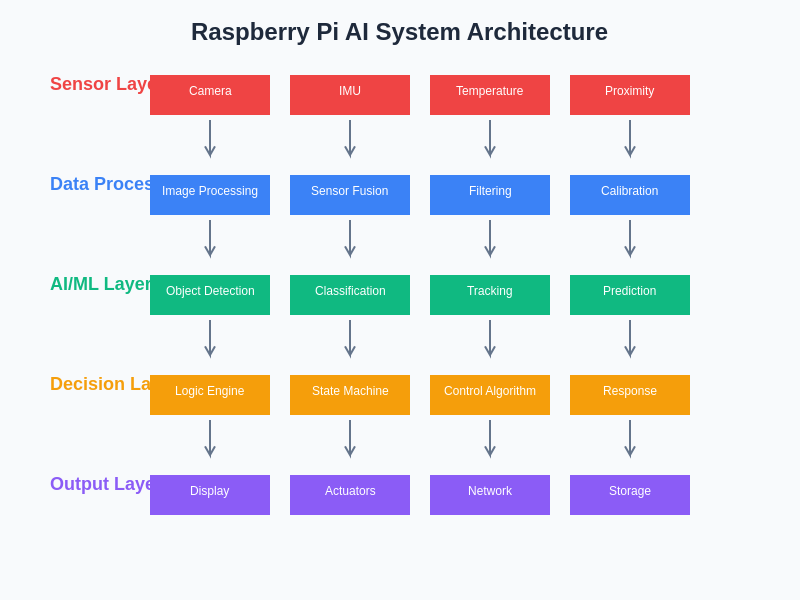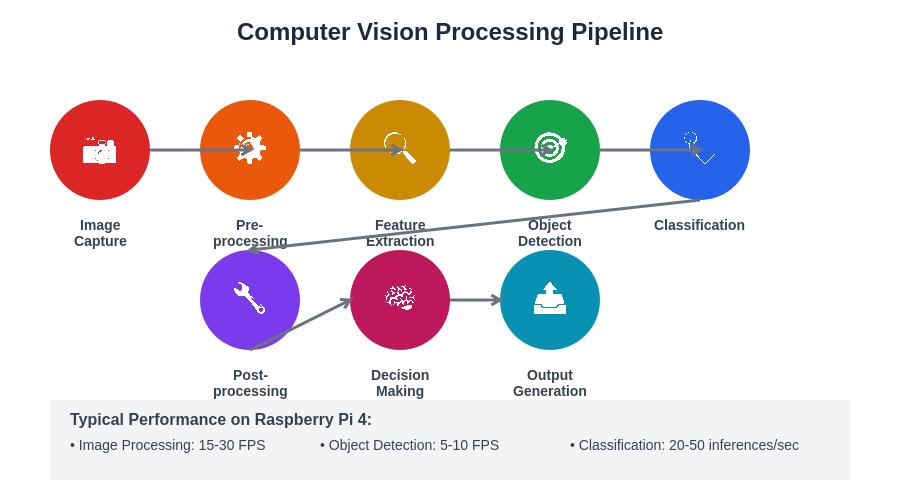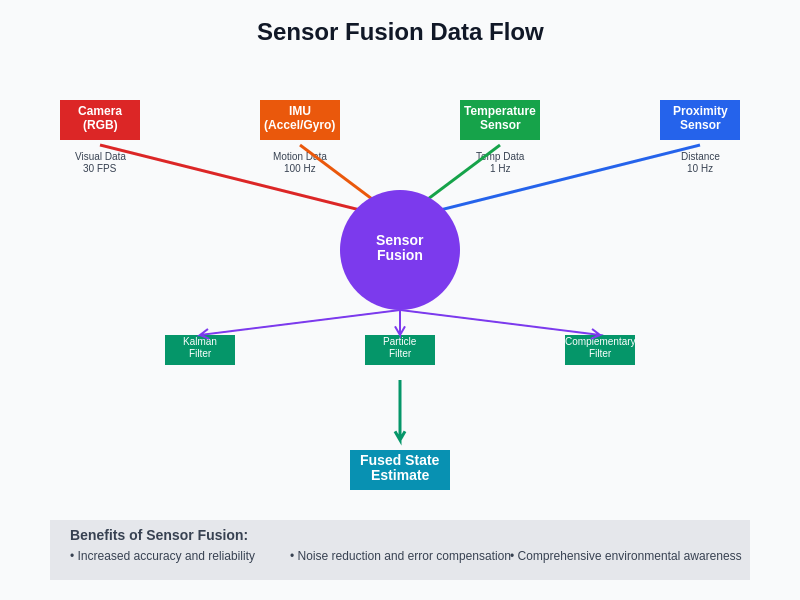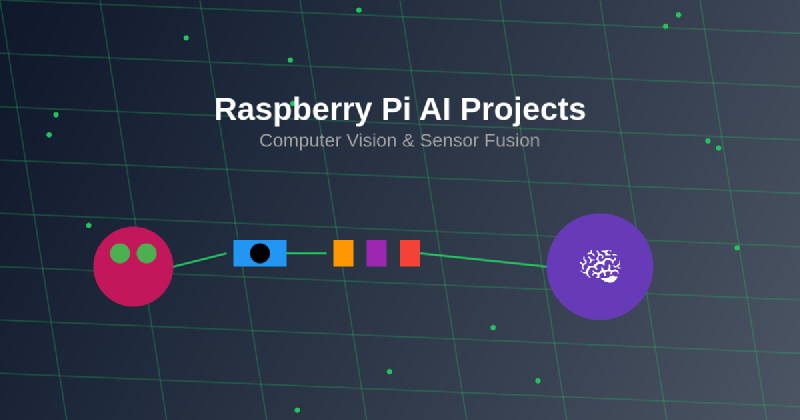The convergence of affordable computing power and sophisticated artificial intelligence algorithms has created unprecedented opportunities for makers, developers, and researchers to explore the frontiers of intelligent systems through accessible hardware platforms. Among these platforms, the Raspberry Pi stands as a revolutionary single-board computer that has democratized access to AI development, enabling countless enthusiasts to transform innovative concepts into tangible, intelligent applications that seamlessly integrate computer vision capabilities with advanced sensor fusion technologies.
Explore the latest AI hardware trends and projects to discover cutting-edge implementations and innovative applications that are pushing the boundaries of what’s possible with compact, intelligent computing systems. The Raspberry Pi ecosystem has evolved far beyond its original educational mission, becoming a cornerstone of modern AI development that bridges the gap between theoretical machine learning concepts and practical, deployable solutions.
The Raspberry Pi Revolution in AI Development
The evolution of the Raspberry Pi from a simple educational tool to a powerful AI development platform represents one of the most significant democratization movements in modern technology. This transformation has been driven by the increasing availability of optimized machine learning frameworks, improved hardware specifications, and a vibrant community of developers who have created extensive libraries and resources for AI implementation. The latest Raspberry Pi models offer sufficient computational power to handle real-time computer vision processing, sensor data analysis, and complex decision-making algorithms that were previously confined to expensive, specialized hardware systems.
The accessibility of the Raspberry Pi platform has fundamentally changed how developers approach AI project development, enabling rapid prototyping, cost-effective deployment, and seamless integration with existing systems. This democratization has led to an explosion of innovative applications across diverse domains, from home automation and security systems to agricultural monitoring and industrial process control. The combination of affordability, versatility, and extensive community support has established the Raspberry Pi as an ideal platform for exploring the intersection of artificial intelligence and edge computing.
Computer Vision Fundamentals on Raspberry Pi
Computer vision represents one of the most compelling and practical applications of artificial intelligence on the Raspberry Pi platform, offering developers the ability to create systems that can perceive, interpret, and respond to visual information in real-time. The implementation of computer vision on Raspberry Pi requires careful consideration of computational constraints, optimization strategies, and algorithm selection to achieve optimal performance within the platform’s hardware limitations. Modern computer vision libraries such as OpenCV, TensorFlow Lite, and specialized Raspberry Pi camera modules have been specifically optimized to leverage the platform’s capabilities while maintaining reasonable processing speeds for practical applications.
The development of computer vision applications on Raspberry Pi encompasses a wide range of techniques, from basic image processing and object detection to advanced pattern recognition and scene understanding. These applications can be enhanced through the integration of pre-trained neural networks, custom machine learning models, and real-time processing pipelines that enable sophisticated visual intelligence capabilities. The availability of high-quality camera modules, including standard RGB cameras, infrared sensors, and specialized imaging hardware, provides developers with flexible options for capturing and processing visual data across various environmental conditions and application requirements.
Experience advanced AI capabilities with Claude for developing sophisticated computer vision algorithms and optimization strategies that maximize performance on resource-constrained hardware platforms. The synergy between powerful AI development tools and accessible hardware platforms creates unprecedented opportunities for innovation in intelligent visual systems.
Essential Hardware Components and Setup
The foundation of successful Raspberry Pi AI projects lies in the careful selection and integration of appropriate hardware components that complement the computational capabilities of the platform while providing reliable sensor inputs and processing performance. The core hardware ecosystem includes the Raspberry Pi board itself, specialized camera modules, various sensors for environmental monitoring, and peripheral components that extend the system’s capabilities. Understanding the specifications, limitations, and optimization potential of each component is crucial for designing effective AI systems that can operate reliably in diverse deployment environments.
Modern Raspberry Pi models offer different performance profiles that must be matched to specific application requirements, with considerations for processing power, memory capacity, connectivity options, and power consumption. The selection of camera modules depends on the specific computer vision requirements, with options ranging from standard RGB cameras for general-purpose vision applications to specialized infrared and depth sensors for advanced perception capabilities. Additional sensors such as accelerometers, gyroscopes, temperature sensors, and proximity detectors can be integrated to create comprehensive sensor fusion systems that provide rich environmental awareness for intelligent decision-making algorithms.
Implementing Object Detection and Recognition
Object detection and recognition represent fundamental capabilities in computer vision systems, enabling Raspberry Pi-based applications to identify, classify, and track specific objects within their field of view. The implementation of these capabilities requires careful consideration of algorithm selection, model optimization, and processing pipeline design to achieve acceptable performance levels on the platform’s computational constraints. Modern approaches leverage pre-trained neural networks that have been optimized for edge computing environments, providing excellent detection accuracy while maintaining reasonable inference speeds for real-time applications.
The development of object detection systems involves multiple stages, including image preprocessing, feature extraction, object localization, and classification, each of which must be optimized for the Raspberry Pi’s hardware architecture. Advanced techniques such as model quantization, pruning, and specialized inference engines can significantly improve performance while maintaining detection accuracy. The integration of these systems with sensor fusion capabilities enables the creation of intelligent applications that can respond to detected objects through coordinated actions, environmental awareness, and predictive behavior patterns.

The architectural design of Raspberry Pi AI systems requires careful consideration of data flow, processing pipelines, and resource allocation to achieve optimal performance across multiple concurrent tasks. This systematic approach ensures efficient utilization of available computational resources while maintaining real-time responsiveness for critical applications.
Advanced Sensor Fusion Techniques
Sensor fusion represents a critical advancement in creating intelligent systems that can combine information from multiple sources to develop comprehensive understanding of their environment and operational context. On the Raspberry Pi platform, sensor fusion techniques enable the integration of visual data from camera systems with environmental information from accelerometers, gyroscopes, magnetometers, temperature sensors, and other specialized monitoring devices. This multi-modal approach to environmental perception creates robust, reliable systems that can operate effectively across diverse conditions and application scenarios.
The implementation of sensor fusion algorithms requires sophisticated data processing techniques that can handle multiple data streams with different sampling rates, accuracy levels, and reliability characteristics. Advanced filtering techniques such as Kalman filters, particle filters, and complementary filters can be employed to combine sensor data optimally, reducing noise, compensating for sensor limitations, and providing accurate state estimation for intelligent decision-making processes. These techniques are particularly valuable in applications such as autonomous navigation, environmental monitoring, and predictive maintenance systems where reliable perception is crucial for successful operation.
Real-Time Processing and Optimization
Achieving real-time performance in Raspberry Pi AI applications requires careful optimization of algorithms, efficient resource management, and strategic use of hardware acceleration capabilities. The constraints imposed by the platform’s computational resources necessitate innovative approaches to algorithm implementation, including the use of approximation techniques, parallel processing strategies, and specialized optimization libraries that can maximize performance while maintaining acceptable accuracy levels. Understanding the performance characteristics of different AI frameworks and their optimization for ARM-based processors is essential for developing responsive, efficient applications.
Optimization strategies encompass multiple levels of the system architecture, from low-level processor optimizations and memory management to high-level algorithm selection and pipeline design. Techniques such as multi-threading, GPU acceleration through specialized libraries, and efficient data structure selection can significantly improve processing performance. The integration of hardware-specific optimizations, including the use of specialized neural processing units and optimized inference engines, enables the development of sophisticated AI applications that can operate effectively within the platform’s resource constraints.
Enhance your AI research capabilities with Perplexity for comprehensive information gathering and analysis of cutting-edge optimization techniques and performance enhancement strategies for edge computing applications. The combination of advanced research tools and practical implementation platforms accelerates the development of innovative AI solutions.
Building Intelligent Surveillance Systems
Intelligent surveillance systems represent one of the most practical and immediately applicable implementations of Raspberry Pi AI technology, combining computer vision capabilities with sensor fusion to create comprehensive security and monitoring solutions. These systems can automatically detect unusual activities, recognize authorized individuals, track movement patterns, and generate alerts based on sophisticated behavioral analysis algorithms. The development of such systems requires integration of multiple AI techniques, including object detection, facial recognition, motion analysis, and pattern recognition, all operating within the computational constraints of the Raspberry Pi platform.
The implementation of intelligent surveillance systems involves careful consideration of privacy concerns, accuracy requirements, and operational reliability, particularly in applications where security decisions may have significant consequences. Advanced features such as person re-identification, behavioral anomaly detection, and predictive alerting can be implemented through sophisticated machine learning models that learn from historical data and adapt to changing environmental conditions. The integration of network connectivity and cloud-based processing capabilities enables these systems to leverage remote computational resources while maintaining local processing capabilities for critical functions.
Agricultural and Environmental Monitoring
The application of Raspberry Pi AI systems in agricultural and environmental monitoring represents a rapidly growing field that combines computer vision, sensor fusion, and predictive analytics to optimize resource utilization and improve crop yields. These systems can monitor plant health, detect pest infestations, analyze soil conditions, and predict weather patterns through the integration of multiple sensing modalities and intelligent data analysis algorithms. The development of such systems requires understanding of agricultural processes, environmental science, and the specific challenges associated with outdoor deployment in variable weather conditions.
Advanced agricultural monitoring systems can implement sophisticated algorithms for crop disease detection, growth stage analysis, and yield prediction through the combination of visual analysis and environmental sensor data. The integration of machine learning models trained on agricultural data enables these systems to provide actionable insights for farmers and agricultural researchers. Environmental monitoring applications extend beyond agriculture to include air quality assessment, wildlife monitoring, and ecosystem health analysis, demonstrating the versatility and broad applicability of Raspberry Pi AI technology.
Autonomous Navigation and Robotics
The integration of computer vision and sensor fusion capabilities enables the development of autonomous navigation systems that can operate effectively in complex, dynamic environments. These systems combine visual odometry, obstacle detection, path planning, and decision-making algorithms to create intelligent robots capable of independent operation across diverse scenarios. The implementation of autonomous navigation on the Raspberry Pi platform requires careful optimization of computational resources, sensor integration strategies, and real-time processing capabilities to achieve reliable performance in practical applications.
Advanced autonomous systems can implement sophisticated capabilities such as simultaneous localization and mapping (SLAM), dynamic obstacle avoidance, and adaptive path planning that enables operation in previously unknown environments. The integration of machine learning algorithms enables these systems to improve their performance through experience, learning optimal navigation strategies and adapting to changing environmental conditions. Applications range from indoor service robots and automated guided vehicles to outdoor exploration systems and autonomous monitoring platforms.

The computer vision processing pipeline illustrates the systematic approach to transforming raw visual data into actionable intelligence through multiple stages of analysis, optimization, and decision-making that maximize the capabilities of resource-constrained hardware platforms.
Edge Computing and Distributed Intelligence
The implementation of edge computing concepts on Raspberry Pi platforms enables the development of distributed intelligent systems that can operate independently while maintaining connectivity for coordination and data sharing. This approach reduces dependence on cloud-based processing, improves response times, and enhances system reliability through distributed decision-making capabilities. The development of edge computing solutions requires understanding of distributed systems architecture, communication protocols, and coordination algorithms that enable effective collaboration between multiple intelligent nodes.
Advanced edge computing implementations can create networks of intelligent devices that share computational resources, coordinate responses to complex situations, and provide redundant capabilities for critical applications. The integration of machine learning models that can be updated and synchronized across multiple devices enables the development of learning systems that improve through collective experience. These distributed intelligence networks find applications in smart cities, industrial monitoring, environmental sensing, and emergency response systems where reliability and responsiveness are crucial for successful operation.
Machine Learning Model Deployment and Optimization
The deployment of machine learning models on Raspberry Pi platforms requires specialized techniques for model optimization, quantization, and efficient inference that can achieve acceptable performance within the platform’s computational constraints. Modern deployment strategies leverage specialized frameworks such as TensorFlow Lite, ONNX Runtime, and platform-specific optimization libraries that can significantly improve inference performance while maintaining model accuracy. Understanding the trade-offs between model complexity, accuracy, and computational requirements is essential for successful deployment of AI applications on edge computing platforms.
Advanced optimization techniques include model pruning, knowledge distillation, and neural architecture search that can create efficient models specifically designed for resource-constrained environments. The integration of hardware acceleration capabilities, including GPU processing and specialized neural processing units, enables the deployment of more sophisticated models that would otherwise be impractical on standard processor architectures. These optimization strategies enable the development of intelligent applications that can leverage state-of-the-art machine learning algorithms while operating effectively on affordable, accessible hardware platforms.
Integration with IoT Ecosystems
The integration of Raspberry Pi AI systems with broader Internet of Things ecosystems creates opportunities for developing comprehensive intelligent solutions that leverage distributed sensing, processing, and control capabilities. These integrated systems can coordinate multiple devices, share intelligence across networks, and provide centralized management of distributed AI applications. The development of IoT-integrated AI systems requires understanding of communication protocols, security considerations, and system architecture design that enables scalable, reliable operation across diverse deployment scenarios.
Advanced IoT integration enables the development of smart environments that can adapt to user preferences, optimize resource utilization, and provide predictive capabilities through coordinated intelligence across multiple devices. The combination of local AI processing with cloud-based analytics creates hybrid systems that can leverage the benefits of both edge computing and centralized processing power. Applications include smart home systems, industrial automation, environmental monitoring networks, and intelligent transportation systems that demonstrate the transformative potential of integrated AI and IoT technologies.

The sensor fusion data flow diagram demonstrates the complex integration of multiple data sources and processing algorithms required to create comprehensive environmental awareness and intelligent decision-making capabilities in resource-constrained computing environments.
Security and Privacy Considerations
The deployment of AI systems on Raspberry Pi platforms raises important considerations regarding data security, privacy protection, and system integrity that must be addressed through comprehensive security architectures and implementation strategies. These considerations are particularly critical in applications involving personal data, surveillance systems, and critical infrastructure monitoring where security breaches could have serious consequences. The development of secure AI systems requires understanding of encryption techniques, access control mechanisms, and secure communication protocols that protect sensitive information while maintaining system functionality.
Advanced security implementations can include techniques such as federated learning, differential privacy, and secure multi-party computation that enable intelligent processing while protecting individual privacy and sensitive information. The integration of hardware security features, secure boot processes, and tamper detection capabilities enhances the overall security posture of deployed systems. These security measures are essential for building trust in AI systems and ensuring their successful adoption across sensitive applications and regulated industries.
Future Developments and Emerging Technologies
The future of Raspberry Pi AI development is being shaped by emerging technologies including neuromorphic computing, quantum-inspired algorithms, and advanced sensor technologies that promise to expand the capabilities and applications of intelligent edge computing systems. These developments will likely enable more sophisticated AI applications, improved energy efficiency, and enhanced processing capabilities that blur the boundaries between edge computing and traditional high-performance computing platforms. Understanding these emerging trends is crucial for developers seeking to create future-ready AI applications that can leverage advancing technology capabilities.
The continued evolution of machine learning algorithms, hardware acceleration technologies, and sensor miniaturization will likely expand the range of applications and improve the performance of Raspberry Pi-based AI systems. Integration with emerging technologies such as 5G connectivity, advanced materials, and biotechnology sensors may create new categories of intelligent applications that were previously impossible or impractical. These developments represent exciting opportunities for innovation and advancement in accessible AI technology that continues to democratize access to sophisticated intelligent computing capabilities.
The trajectory of Raspberry Pi AI development suggests a future where intelligent edge computing becomes ubiquitous, enabling the creation of responsive, adaptive systems that enhance human capabilities and improve quality of life across diverse applications and environments. This evolution will require continued innovation in algorithms, hardware design, and system integration to realize the full potential of distributed artificial intelligence.
Disclaimer
This article is for informational purposes only and does not constitute professional advice. The views expressed are based on current understanding of AI technologies and their applications in edge computing environments. Readers should conduct their own research and consider their specific requirements when implementing AI-powered systems on Raspberry Pi platforms. The effectiveness of AI applications may vary depending on specific use cases, hardware configurations, and implementation approaches. Safety and security considerations should be thoroughly evaluated for any AI system deployment.
